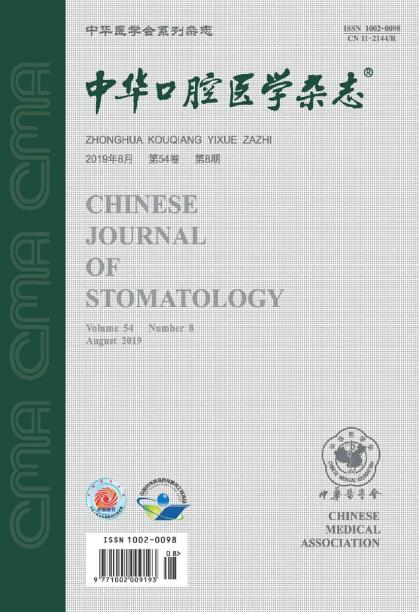[通过单细胞和空间转录组学综合分析口腔扁平苔藓和口腔类地衣病变中B细胞的结构表型和功能特征]。
摘要
目的:全面表征口腔扁平苔藓(OLP)及相关口腔苔藓样病变(OLL)的B细胞表型和空间分布,重点进行转录组学分析和功能分析,揭示口腔粘膜微环境中B细胞介导的免疫调节的表观遗传机制。方法:单细胞RNA测序原始数据来源于GSE211630数据库,包括2例糜烂性口腔扁平苔藓(EOLP), 3例非糜烂性口腔扁平苔藓(NEOLP)和1例健康对照(NORMAL)的样本。在严格的质量控制下,对数据进行归一化、高变量基因选择和批次效应校正。随后的分析包括降维和无监督聚类来识别不同的细胞群。本研究收集了于2021年1月至2023年12月在上海交通大学医学院附属上海第九人民医院口腔黏膜科治疗的3例OLP/OLL患者和3例健康对照者的病理标本。利用10X Genomics Visium HD空间转录组学技术,对组织切片进行脱蜡、染色和组织学成像处理,重建核酸结构,获取基因表达谱。数据分析包括质量评估、基因量化、归一化、降维和聚类。此外,使用稳健细胞类型分解(RCTD)算法进行细胞类型反卷积,整合单细胞转录组数据,以准确预测和空间解析组织微环境中的细胞类型分布。结果:综合EOLP、NEOLP和健康对照的单细胞数据,将细胞分为7大类:B/浆细胞、内皮细胞、上皮细胞、成纤维细胞、髓样细胞、平滑肌细胞和T/NK细胞。三组间B/浆细胞比例差异显著,分别占总细胞数的10.7%(1 693/15 815)、3.8%(833/21 653)和0.4%(47/11 556)。进一步的B/浆细胞聚类分析确定了4个不同的亚群:幼稚B细胞、活化B细胞、记忆B细胞和浆细胞。在EOLP组,这些亚群分别占B/浆细胞总数的25.9%(348/1 344)、45.9%(617/1 344)、3.3%(45/1 344)和24.9%(334/1 344)。NEOLP组分别为31.6%(195/617)、59.6%(368/617)、0.2%(1/617)和8.6%(53/617)。而NORMAL组仅检测到浆细胞。空间分析显示,B细胞在OLP/OLL样品的不同阶段积极参与三级淋巴样结构(TLS)的形成,其中二级滤泡样TLSs的结构组织突出。在这些结构中,T细胞标记基因CD3E和B细胞标记基因MS4A1的表达显著升高。此外,在继发性滤泡样TLSs中,编码滤泡树突状细胞分泌蛋白的基因、生发中心标记基因B细胞淋巴瘤6和激活诱导胞苷脱氨酶的基因也表现出强表达。在OLP/OLL样本中,浆细胞标记基因CD38、免疫球蛋白(IGH) G3、IGHG1、IGHM、IGHD、IGHE、免疫球蛋白Kappa常数、免疫球蛋白α 1、免疫球蛋白Lambda常数1和补体基因C3均有高水平表达。结论:与正常粘膜相比,OLP和OLL均可见广泛的b细胞浸润,且b细胞表型和比例存在显著差异。B细胞似乎在局部免疫反应中发挥核心作用,主要是通过形成TLSs。然而,它们参与的确切功能机制需要进一步研究。Objective: Comprehensive characterization of B-cell phenotypes and spatial distribution in oral lichen planus (OLP) and related oral lichenoid lesions (OLL)(OLP/OLL), with an emphasis on transcriptomic profiling and functional analysis, to uncover the epigenetic mechanisms underlying B cell-mediated immune regulation within the oral mucosal microenvironment. Methods: Single-cell RNA sequencing raw data were sourced from the GSE211630 database, encompassing samples from 2 cases of erosive OLP (EOLP), 3 cases of non-erosive OLP (NEOLP) and 1 healthy control (NORMAL). Following stringent quality control, the data underwent normalization, selection of highly variable genes and batch effect correction. Subsequent analyses included dimensionality reduction and unsupervised clustering to identify distinct cell populations. This study collected pathological specimens from 3 OLP/OLL patients and 3 healthy controls who were treated at the Department of Oral Medicine, Shanghai Ninth People's Hospital, Shanghai Jiao Tong University School of Medicine from January 2021 to December 2023. Using 10X Genomics Visium HD spatial transcriptomics technology, tissue sections were processed through dewaxing, staining and histological imaging, enabling the reconstruction of nucleic acid structures and the capture of gene expression profiles. Data analysis included quality assessment, gene quantification, normalization, dimensionality reduction and clustering. Furthermore, cell type deconvolution was performed using the robust cell type decomposition algorithm, integrating single-cell transcriptomic data to accurately predict and spatially resolve cell type distributions within the tissue microenvironment. Results: After integrating single-cell data from EOLP, NEOLP and NORMAL, cells were classified into seven major categories: B/plasma cells, endothelial cells, epithelial cells, fibroblasts, myeloid cells, smooth muscle cells and T/natural killer cells. The proportion of B/plasma cells varied significantly among the three groups, accounting for 10.7% (1 693/15 815), 3.8% (833/21 653) and 0.4% (47/11 556) of the total cells respectively. Further clustering analysis of B/plasma cells identified four distinct subpopulations: naive B cells, activated B cells, memory B cells and plasma cells. In the EOLP group, these subpopulations constituted 25.9% (348/1 344), 45.9% (617/1 344), 3.3% (45/1 344) and 24.9% (334/1 344) of the B/plasma cells respectively. In the NEOLP group, they represented 31.6% (195/617), 59.6% (368/617), 0.2% (1/617) and 8.6% (53/617). Howerer, only plasma cells were detected in the NORMAL group. Spatial analysis revealed that B cells were actively involved in the formation of tertiary lymphoid structures (TLS) at various stages in OLP/OLL samples, with a prominent structural organization observed in secondary follicle-like TLS. Within these structures, the expressions of T cells marker gene CD3E and B cells marker gene MS4A1 were significantly elevated. Additionally, in secondary follicle-like TLS, the gene encoding follicular dendritic cell secreted protein, germinal center marker gene B cell lymphoma 6 and the gene for activation induced cytidine deaminase also showed strong expression. In OLP/OLL samples, plasma cell marker gene CD38, immunoglobulin (IGH) G3, IGHG1, IGHM, IGHD, IGHE, imunoglobulin Kappa constant, immunoglobulin alpha 1, immunoglobulin Lambda constant 1 and complement gene C3 all exhibited high levels of expression. Conclusions: Compared to normal mucosa, extensive B-cell infiltration is observed in both OLP and OLL, accompanied by significant differences in B-cell phenotypes and proportions. B cells appear to play a central role in local immune responses, primarily through the formation of TLS. However, the precise functional mechanisms underlying their involvement require further investigation.

 求助内容:
求助内容: 应助结果提醒方式:
应助结果提醒方式:


